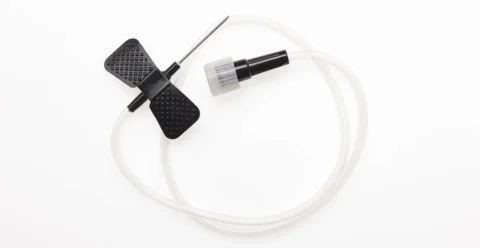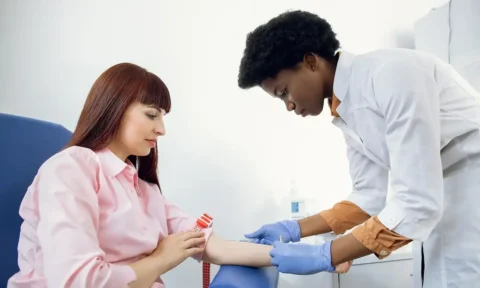Butterfly needles are medical devices that healthcare professionals use to access veins for collecting blood samples or administering intravenous laboratory medicine. They’re smaller than most standard straight needle sizes, making them ideal for drawing venous blood from the narrow veins of children and older patients.
So what do you call the tool that transfers the blood from the butterfly needle into the ACD tube and other blood collection tubes? Blood can be transferred from the butterfly needle to the collection tube as it passes through the plastic tubing that’s connected to the needle holder. Tube lengths usually range from 8 inches to 15 inches.
Familiarizing Yourself With Butterfly Needles and Other Venipuncture Materials
Venipuncture (also known as a blood draw or phlebotomy) is an important medical process that healthcare professionals use to run different tests and evaluate the patient’s overall health. To prevent blood specimen contamination and inaccurate test results, phlebotomists should be meticulous during the entire process – from selecting the right needle system and collecting blood specimens in the right order to processing them in the clinical laboratory.
Another important part of venipuncture is knowing which tools to use and how to use them when collecting a blood sample. When transferring the blood from the butterfly needle into the ACD specimen tube or any other collection tube, the winged infusion set comes with plastic tubing that connects the hypodermic needle to the needle holder.
Here are some of the most common medical equipment that you need to prepare for phlebotomy:
1. Butterfly Needles
Butterfly needles are also known as winged infusion sets or scalp vein sets. They got their name from the plastic wings on both sides of the hollow needle. Each butterfly needle is also attached to plastic tubing. Some of them also come with a Luer lock, a connecting device that can be twisted into a syringe. Butterfly needles can also be connected to a vacutainer tube for specimen collection.
Due to their small size, butterfly needles are often recommended for drawing blood samples from smaller veins of children and old patients. They’re also designed for a more accurate placement than straight needles, which often wiggle or roll. Butterfly needles are also utilized for drawing blood from the small veins found in the hand, heel, or scalp.
Like standard needles, butterfly needles also come in different gauge sizes – the higher the gauge number is, the thinner the needle will be. For blood collection using butterfly needles, a 23-gauge needle is most commonly used. It has light blue-colored wings to easily tell it apart from other needle sizes. Using smaller needle sizes may only result in hemolysis and affect the blood test results.
2. Collection Tubes
Blood collection tubes are for storing the blood collected from the patient’s vein and for processing the sample in the laboratory. They come in a rainbow of colors that denote particular functions and laboratory tests. Some also contain additives so it’s important to avoid messing them up for more accurate test results.
The colored stopper of a blood collection tube also tells the phlebotomist the correct order of draw. This is the particular order that should be followed at all times:
- Blood culture
- Light blue top (contains 3.2% sodium citrate and clot activator for coagulation tests)
- Red top (plain and with gel for blood chemistry and reference tests)
- Green top (both with and without gel; contains lithium heparin for chemistry tests)
- Pink or lavender top (contains EDTA for blood bank testing and hematology)
- Gray top (contains potassium oxalate or sodium fluoride for glucose testing)
- Yellow top (contains acid citrate dextrose or ACD solution for genetics testing)
Each collection tube is manufactured as an evacuated tube with a seal to minimize the risk of contamination. When the butterfly needle is inserted into the skin, the vacuum allows blood to flow from vein to tube.
However, there are times when a vacuum tube malfunctions. This requires phlebotomists to get another tube to complete the blood collection. It’s best to keep a few extra blood collection tubes in the blood draw kit in case this happens.
3. Tourniquet
A tourniquet is another important tool used by phlebotomists during venipuncture. It’s a band that squeezes the arm and compresses the veins, preventing some of the blood from returning to the heart. Using a tourniquet causes the veins under the area to fill with blood and swell, allowing phlebotomists to see the veins better and make the venipuncture process a lot easier.
The tourniquet is placed about 3 to 4 inches above the area where you plan to inject the butterfly needle (usually in the forearm). Once the patient’s arm is correctly positioned, tie the tourniquet under the forearm by crossing its ends once and partially tucking the loose end. Phlebotomists should also remember to remove the tourniquet immediately after all the required blood samples have been collected.
4. Alcohol Wipes
Alcohol wipes are one of the most used products by phlebotomists. They use wipes and swabs to disinfect an area before the needle is inserted there. This prevents potential contamination of the samples. For this reason, it’s crucial for phlebotomists to always remember to open the pack of alcohol wipes using their gloves before starting the venipuncture.
After finding the target vein (usually the antecubital fossa or basilic vein) where the butterfly needle will be inserted, the phlebotomist must disinfect the injection site using a pad with 70% isopropyl alcohol. Wipe the area in a circular motion, moving in an outward spiral from the puncture site. Throw the alcohol wipe immediately after use.
5. Gloves
Gloves are a type of personal protective equipment that protects healthcare professionals and their patients. Before each venipuncture procedure, the phlebotomist washes their hands thoroughly and then wears non-sterile examination or latex gloves.
Doing this prevents the possible transfer of pathogens from the phlebotomist’s hands to the patient. Contaminants may easily enter the patient’s body through the puncture wound created by the butterfly needle. Wearing gloves is also important because it protects phlebotomists from possible blood pathogens from the patient.
The gloves should also perfectly fit the phlebotomist’s hands, allowing them to easily handle different venipuncture materials. Each glove should also be carefully removed and thrown away after every use. Make sure that your bare hands won’t touch the outside of the gloves. After disposing of the gloves, wash your hands again to get rid of any pathogens.
6. Gauze
At the end of each venipuncture procedure, phlebotomists need to remove the needle and check the injection site for bleeding and signs of hematoma. A gauze pad is also placed over the puncture wound to apply pressure to it, stop the bleeding, and encourage blood clotting. This prevents any bruising that may happen at the injection site.
After ensuring that there isn’t any abnormality in the blood collection area, the phlebotomist secures the gauze using medical tape. They may also use bandages as an alternative to gauze pads. Whether a gauze pad or bandage is used, it should remain there for some time until the injection site heals and closes.
7. Disposal Unit
Disposal units like puncture-resistant sharps containers are required during venipuncture procedures. Phlebotomists put the used needles in the disposal unit after the venipuncture to limit everyone’s exposure to blood pathogens and minimize the risk of accidental needlestick injury.
A disposal unit also offers phlebotomists safe and proper disposal of used butterfly needles and other tools used to puncture the skin. It’s usually bright red with a biohazard sign printed on its front.
Using Butterfly Needles for Blood Collection
Butterfly needles are especially useful for venipuncture procedures on thin and hard-to-access veins. Here’s everything you need to know about using them in blood collection procedures:
1. Butterfly Needles and Their Uses
A butterfly needle is a small needle with plastic wings that act as a stabilizer when the needle pierces the skin. It’s also often used as an alternative to the intravenous catheter during IV fluid therapy or the administration of intravenous medications.
Blood collection using butterfly needles is typically performed on children, older patients, and some adults with thin veins. It’s also the recommended needle type for patients with rolling veins or those who are hesitant about needles.
Butterfly needles come in different gauge sizes, but the best one to use for blood collection is the 23-gauge needle which has light blue plastic wings. Some phlebotomists may also use 25-gauge needles, but doing so increases the risk of hemolysis (destruction of red blood cells). Hemolyzed blood samples affect the blood test results because hemolysis falsely increases or decreases the value of some of the blood components.
2. How to Use Butterfly Needles
During the blood draw, a phlebotomist holds the butterfly needle by its plastic wings between the index finger and thumb. Thanks to the short length of the hypodermic needle, the phlebotomist needs to hold the needle closely. This results in a more accurate placement of the butterfly needle compared to a straight needle.
The butterfly needle is inserted toward the target vein at a shallow angle. The venous pressure causes some blood to get into the transparent tubing (“blood flash”), a sign that the needle is correctly placed in the target vein. Phlebotomists may also use the wings to stabilize the needle and prevent it from shifting or rolling. They must also place the corresponding collection tube into the tube holder to collect blood.
After drawing the needed amount of blood, the phlebotomist must throw the entire winged infusion set into the sharps disposal unit. They should also bandage the puncture wound and label the blood specimen properly.
3. Advantages of Using Butterfly Needles
- Better access to superficial veins, as well as small or narrow veins
- Recommended for infants, children, elder patients, and some adult patients
- A lot less painful to use compared to straight needles
- Recommended for patients with spastic veins
- Less likely to cause profuse bleeding, vein collapse, or nerve injury as long as the needle is carefully removed
- Comes in slide-and-lock sheaths to prevent needle reuse and needlestick injuries
4. Disadvantages of Using Butterfly Needles
- Slower blood collection
- Not recommended for urgent situations and squeamish patients
- May result in blockage if the wrong needle size is chosen
- May cause vein damage if the unit is suddenly yanked from the injection site
- Should only be used for IV infusion therapies that last for 5 hours or less
High-Quality Venipuncture Equipment and More at FACE Med Store
Butterfly needles come with plastic tubing which allows the blood to flow from the vein into the collection tube. Getting familiar with the different parts of a winged infusion set as well as their functions allows phlebotomists to use them properly and avoid accidents during a venipuncture procedure.
For the best butterfly needles of different sizes, ask our staff at FACE Med Store today about the best venipuncture needles and other medical equipment. We partner with hundreds of medical professionals around the country to provide them with different medical supplies at the right price. Know more about our different venipuncture equipment and other products, and call us today.






